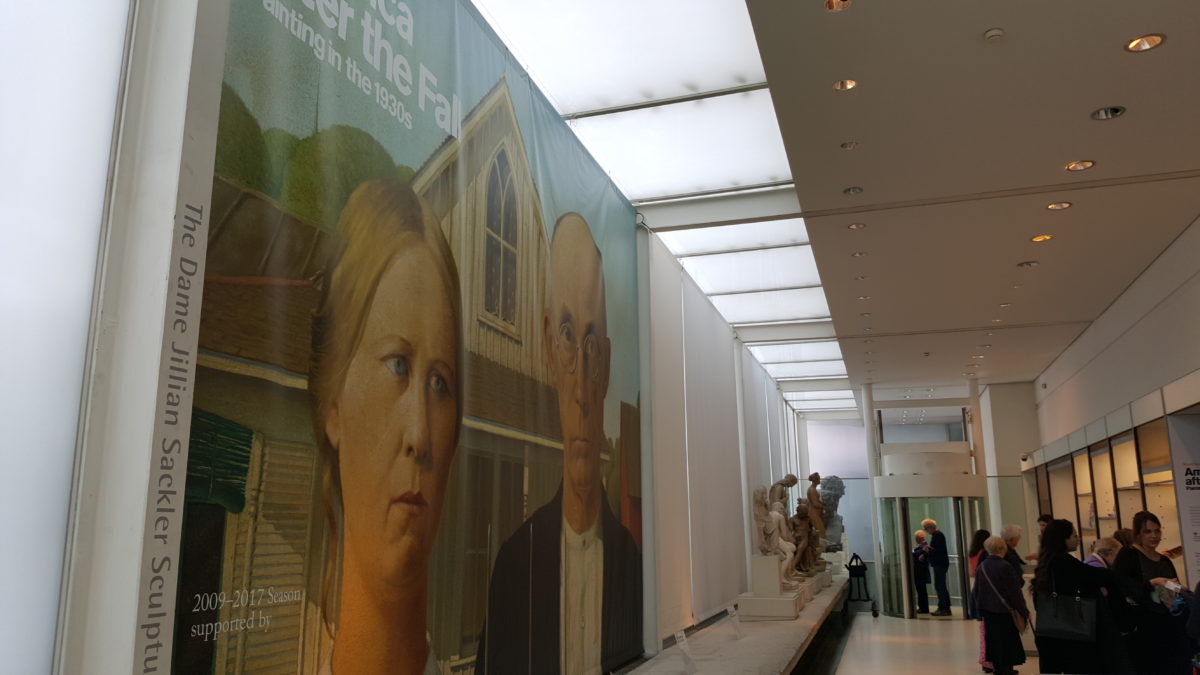America After the Fall – Royal Academy, London
I intend to go back to this exhibition again before it closes. Not because I loved it so much I just have to (this remains to be seen) but because the main drawbacks I found with this exhibition were organisational and design constraints: too many people, wall texts too hard to read and not enough patience on the day to deal with either. The end result was that I made a hasty retreat. I have a feeling that, if I can find a time to see it at a more leisurely pace, I will enjoy the return visit.
In terms of current offerings, the RA is definitely having a moment between this and Revolution in the main galleries downstairs. Especially insomuch as the time periods covered overlap, it’s an interesting chance to see the reactions in American and Russian art to a time of great upheaval at home and abroad. Revolution for me comes out on top, but I did wonder whether having the expanded space of the main galleries to unpack the meaning and the artists on display would have aided the curatorial vision of America After the Fall, or exacerbated the issues and diluted the focus.
To deal with the issues first, they were for me largely practical ones. It was crowded. On a weekday afternoon. This is not an uncommon occurrence in London, but other institutions which are prone to it, such as the National Gallery, have the foresight to manage the flow of people by providing each visitor with a copy of the exhibition texts in their gallery guide so they don’t have to crowd around certain spots on the wall. No such luck at the Royal Academy, where the the handout instead gives (admittedly interesting) background information on some of the artists, and points to a paid gallery guide which I didn’t see any sign of. Compounding this, the font and colour of the wall texts mean that you have to be rather close to read anything: I saw one couple stand in front of a picture discussing the issue before giving up and moving on, unable even to make out that the label was nothing more interesting than museum provenance. A final gripe on organisation and design: the layout was slightly confusing, moving around the rooms in the opposite direction from other exhibitions I’ve seen in the same space, but without clear signage.
So much for my complaints, although they did have a bearing on the time I spent in the exhibition, and thus my desire to return and spend more time with the artworks. From what I’ve seen so far, curator Judith Banter (of the Art Institute of Chicago) has packed a lot into a relatively small selection of works: urban and rural viewpoints, well-known and lesser-known artists, the march of progress and the fear of the unknown, female and black experiences. A couple of the works are fantastic: Philip Guston’s 1937 tondo ‘Bombardment’ manages to echo Michelangelo while depicting gas masks and war planes, and the works by Edward Hopper portray a big-city loneliness that speaks to the period’s nostalgia. Some artists are represented by multiple works, either contrasting or complementary. To take one artist, Grant Wood, it’s his iconic work ‘American Gothic’ which is on all the promotional materials and gets people through the door, but some of his other paintings on display, while not as layered or debated, show a distinctive style and vision and, to me, parallels with someone like Stanley Spencer which I wouldn’t have seen had only ‘American Gothic’ been included. Other works are not quite to the same level of achievement, but shine a light on different aspects of the Depression-era experience.
A strong, or at least thoughtful and sometimes unexpected, choice of paintings, then, held back somewhat by a couple of design flaws. What to do on my planned return visit? If I’m able to pick my moment and tune out other visitors, I would like to take in the works one by one and as a whole: I suspect the curatorial work on this exhibition really is quite good, but need to test this theory by not rushing through and out. Maybe if I can track down this gallery guide it will help, or maybe it’s a case of needing to buy the catalogue and absorb the works in my own time.
Until 4 June


